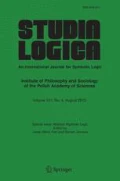Abstract
How can formal methods be applied to philosophical problems that involve informal concepts of ordinary language? Carnap answered this question by describing a methodology that he called “explication." Strawson objected that explication changes the subject and does not address the original philosophical problem; this paper shows that Carnap’s response to that objection was inadequate and offers a better response. More recent criticisms of explication by Boniolo and Eagle are shown to rest on misunderstandings of the nature of explication. It is concluded that explication is an appropriate methodology for formal philosophy.
Similar content being viewed by others
References
Boniolo, Giovanni (2003). ‘Kant’s explication and Carnap’s explication: The Redde Rationem’. International Philosophical Quarterly 43(3): 289–298
Carnap, Rudolf, Logical Foundations of Probability, University of Chicago Press, Chicago, 1950. Second edition 1962.
Carnap, Rudolf (1956) ‘The methodological character of theoretical concepts’. Minnesota Studies in the Philosophy of Science 1: 38–76
Carnap, Rudolf, ‘Replies and systematic expositions’, in Schilpp [12], pp. 859–1013.
Eagle, Antony (2004) ‘Twenty-one arguments against propensity analyses of probability’. Erkenntnis 60: 371–416
Good I.J. (1968) ‘The white shoe qua herring is pink’. British Journal for the Philosophy of Science 19: 156–157
Hempel, Carl G., ‘Studies in the logic of confirmation’, Mind, 54 (1945), 1–26 and 97–121. Reprinted with some changes in Aspects of Scientific Explanation, Carl G. Hempel. New York: The Free Press, 1965.
Maher, Patrick, ‘Probability captures the logic of scientific confirmation’, in Christopher R. Hitchcock (ed.), Contemporary Debates in Philosophy of Science, Blackwell, Oxford, 2004, pp. 69–93.
Nicod, Jean, Le Probl‘eme Logique de l’Induction, Alcan, Paris, 1923. Page references are to the English translation in [10].
Nicod, Jean, Geometry and Induction, University of California Press, Berkeley and Los Angeles, 1970. English translation of works originally published in French in 1923 and 1924.
Quine, Willard Van Orman (1960). Word and Object. MIT Press, Cambridge, Mass
Schilpp, Paul Arthur (ed.), The Philosophy of Rudolf Carnap, Open Court, La Salle, IL, 1963.
Strawson, P. F., ‘Carnap’s views on constructed systems versus natural languages in analytic philosophy’, in Schilpp [12], pp. 503–518.
Author information
Authors and Affiliations
Corresponding author
Additional information
Special Issue Formal Epistemology I. Edited by Branden Fitelson
Rights and permissions
About this article
Cite this article
Maher, P. Explication Defended. Stud Logica 86, 331–341 (2007). https://doi.org/10.1007/s11225-007-9063-8
Published:
Issue Date:
DOI: https://doi.org/10.1007/s11225-007-9063-8


